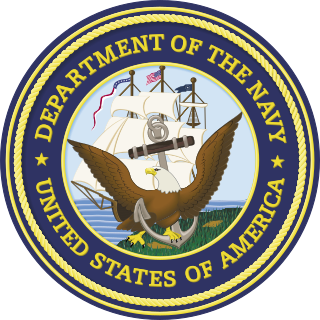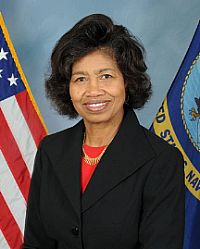Related Research Articles

The Naval Air Systems Command (NAVAIR) provides materiel support for aircraft and airborne weapon systems for the United States Navy. It is one of the Echelon II Navy systems commands (SYSCOM), and was established in 1966 as the successor to the Navy's Bureau of Naval Weapons.

The Naval Information Warfare Center Pacific, formerly the Space and Naval Warfare Systems Center Pacific, the Naval Command, Control and Ocean Surveillance Center (NCCOSC) RDT&E Division, the Space and Naval Warfare Systems Center San Diego, and the Naval Ocean Systems Center (NOSC), provides the U.S. Navy with research, development, delivery and support of integrated command, control, communications, computers, intelligence, surveillance and reconnaissance (C4ISR), cyber and space systems and capabilities across all warfighting domains. The only Naval technical center headquartered in a major fleet concentration area, NIWC Pacific manages strategic locations both in the Pacific theater and around the world.

The Naval Information Warfare Systems Command (NAVWAR), based in San Diego, California is one of six SYSCOM Echelon II organizations within the United States Navy and is the Navy's technical authority and acquisition command for C4ISR, business information technology and space systems. Echelon II means that the organization reports to someone who, in turn, reports directly to the Chief of Naval Operations on the military side. From a civilian perspective, NAVWAR reports to the Assistant Secretary of the Navy (RDA). The command was formerly known as Space and Naval Warfare Systems Command (SPAWAR) and was renamed in June 2019 to better align its identity with its mission.
In the United States Navy, commissioned officers are either line officers or staff corps officers. Staff corps officers are specialists in career fields that are professions unto themselves, such as physicians, lawyers, civil engineers, chaplains, and supply specialists. For example, a physician can advance to become the commanding officer (CO) of a hospital, the medical hospital on a hospital ship or large warship, or a medical school; or the Chief of the Medical Corps or of the Bureau of Medicine and Surgery. A supply officer can become the CO of a supply depot or a school, or the head of the Naval Supply Systems Command, etc.

The Naval Air Warfare Center Training Systems Division (NAWCTSD) is an Echelon IV command of the United States Navy, reporting to the Commander, Naval Air Warfare Center - Aircraft Division (NAWCAD) at NAS Patuxent River, Maryland. NAWCTSD is located in Orlando, Florida in the Central Florida Research Park, adjacent to the University of Central Florida (UCF). The facility is a part of a larger military installation within the Central Florida Research Park known as Naval Support Activity Orlando.

The Marine Corps Systems Command (MCSC) is the acquisition command of the United States Marine Corps, made up of Marines, sailors, civilians and contractors. As the only systems command in the Marine Corps, MCSC serves as Head of Contracting Authority and exercises technical authority for all Marine Corps ground weapon and information technology programs. MCSC is headquartered at Marine Corps Base Quantico.
The Naval Facilities Engineering Systems Command (NAVFAC) is the United States Navy's engineering systems command, providing the Navy and United States Marine Corps with facilities and expeditionary expertise. NAVFAC is headquartered at the Washington Navy Yard and is under the command of the Chief of Civil Engineers RADM Dean VanderLey
The Department Of the Navy Acquisition Intern Program is a civilian professional hiring program. The Naval Acquisition Career Center manages several hundred interns at any given time.
Naval Air Warfare Centers are research organizations within Naval Air Systems Command. The centers are grouped within the following divisions:

The Naval Supply Systems Command (NAVSUP) serves as the supply command for the United States Navy for providing supplies, services, and support to both the Navy and the United States Marine Corps.
The Navy Meritorious Civilian Service Award is awarded to civilian employees in the Department of the Navy for meritorious service or contributions resulting in high value or benefits for the Navy or the Marine Corps. It is conferred for a contribution that applies to a local or smaller area of operation or a project of lesser importance than would be warranted for consideration for the Navy Distinguished Civilian Service Award or the Navy Superior Civilian Service Award. It is awarded by the local activity head to U.S. Navy employees for service or contributions resulting in high value or benefit to the Department of Navy. The award consists of a certificate and citation signed by the activity head, medal and lapel emblem. The award is the third highest Navy civilian award, ranking just behind the Navy Superior Civilian Service Award, which is itself behind the Navy Distinguished Civilian Service Award.

Gladys Lee Commons is the former United States Assistant Secretary of the Navy.

The Naval Sea Systems Command (NAVSEA) is the largest of the United States Navy's five "systems commands," or materiel organizations. From a physical perspective, NAVSEA has four shipyards for shipbuilding, conversion, and repair, ten "warfare centers", the NAVSEA headquarters, located at the Washington Navy Yard, in Washington D.C., and other locations in 15 states and 3 overseas continents.

The Assistant Secretary of the Navy (Research, Development and Acquisition) (abbreviated ASN (RDA)) is a civilian office of the United States Department of the Navy. The Assistant Secretary of the Navy (Research, Development and Acquisition) requires Senate confirmation, and engages in duties as directed by the United States Secretary of the Navy.
The Navy Civilian Service Achievement Medal is awarded to Department of the Navy and U.S. Marine Corps civilians who, while serving in a capacity within the Navy or Marine Corps, are to be recognized for sustained performance or specific achievement of a superlative nature at the equivalent level of the Navy and Marine Corps Achievement Medal awarded to military personnel.

The Naval Air Systems Command Program Executive Offices(PEOs) are organizations responsible for the prototyping, procurement, and fielding of naval air equipment. Their mission is to develop, acquire, field and sustain affordable and integrated state of the art equipment for the Navy.

The Naval Information Warfare Systems Command Program Executive Offices(PEOs) are organizations responsible for the prototyping, procurement, and fielding of C4ISR (Command, Control, Communications, Computers, Intelligence, Surveillance and Reconnaissance), business information technology and space systems. Their mission is to develop, acquire, field and sustain affordable and integrated state of the art equipment for the Navy.

The six Naval Sea Systems Command Program Executive Offices(PEOs) are responsible for the development and acquisition of naval platforms and weapons systems. Their mission is to develop, acquire, field and sustain affordable and integrated state of the art equipment for the Navy and Marine Corps.

Underwater Construction Teams (UCT) are the United States Navy Seabees' underwater construction units numbered 1 and 2 that were created in 1974. A team is composed of divers qualified in both underwater construction and underwater demolition. Possible tasks can be: battle damage repairs, structural inspections and assessments, demolition of waterline facilities or submerged obstructions, installation of submerged surveillance systems, or harbor and channel clearance. As needed, teams may test and or evaluate new or existing aquatic systems or equipment. Extending construction, whether vertical or horizontal, beyond the shoreline and waterline is their specialty. Reflecting Seabee tradition, teams are expected to execute underwater construction anywhere, anytime, under any conditions.
References
- ↑ "ASN(RDA) Overall Structure". Assistant Secretary of the Navy for Research, Development & Acquisition. Retrieved 13 February 2023.
- 1 2 "Navy SBIR / STTR Program". U.S. Department of the Navy. Retrieved 23 August 2014.
- ↑ "About NAVSEA". U.S. Naval Sea Systems Command. Archived from the original on 8 October 2014. Retrieved 23 August 2014.
- ↑ "About us". U.S. Naval Air Systems Command. Retrieved 23 August 2014.
- 1 2 3 4 "Naval Air Systems Command (NAVAIR)". GlobalSecurity.org. 5 July 2011. Retrieved 22 August 2014.
- ↑ "About us". U.S. Space and Naval Warfare Systems Command. Archived from the original on 26 August 2014. Retrieved 23 August 2014.
- 1 2 "Space and Naval Warfare Systems Command (SPAWAR)". GlobalSecurity.org. 5 July 2011. Retrieved 22 August 2014.
- ↑ "About us". U.S. Naval Facilities Engineering Command. Retrieved 23 August 2014.
- 1 2 "Naval Facilities Engineering Command (NAVFAC)". GlobalSecurity.org. 5 July 2011. Retrieved 22 August 2014.
- ↑ "Capabilities". U.S. Naval Supply Command. Retrieved 23 August 2014.
- ↑ "Naval Supply Systems Command (NAVSUP)". GlobalSecurity.org. 5 July 2011. Retrieved 24 October 2014.
- 1 2 "Overview and history". Marine Corps Systems Command. Retrieved 22 August 2014.
- 1 2 "Commander, Naval Air Systems Command". U.S. Naval Air Systems Command. Retrieved 22 August 2014.
- 1 2 "Leadership". U.S. Naval Sea Systems Command. Retrieved 22 August 2014.
- 1 2 "Brady, Patrick, Rear Admiral: NIWC Commander". U.S. Space and Naval Warfare Systems Command. Retrieved 22 August 2014.
- 1 2 "Key Leadership". U.S. Naval Facilities Engineering Command. Retrieved 22 August 2014.
- 1 2 "Command Biographies". U.S. Naval Supply Systems Command. Retrieved 22 August 2014.
- 1 2 "MCSC Leaders". U.S. Marine Corps Systems Command. Retrieved 22 August 2014.
- ↑ "Staff Corps". U.S. Bureau of Naval Personnel. Retrieved 23 August 2014.
- ↑ "Chief of Naval Operations (CNO)". GlobalSecurity.org. 5 July 2011. Retrieved 24 October 2014.
- ↑ NRL Fact Book. Washington, DC: U.S. Naval Research Laboratory. 2014. p. 2.
- ↑ "Bureau of Supplies and Accounts". Navy History and Heritage Command. 4 December 2006. Retrieved 22 August 2014.
- ↑ "Naval Sea Systems Command (NAVSEA)". GlobalSecurity.org. 5 July 2011. Retrieved 22 August 2014.